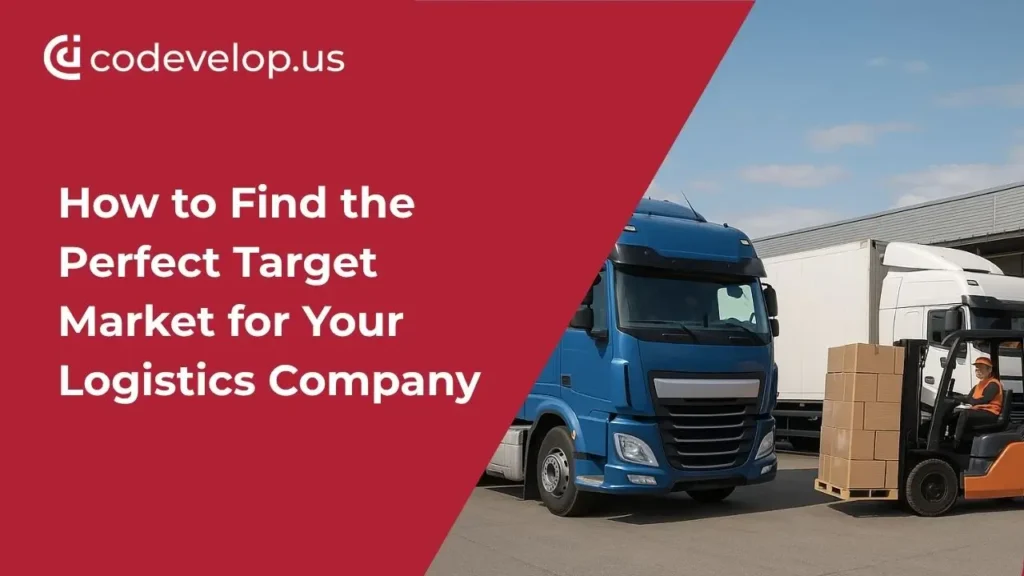Choosing the right target market can make or break your logistics business. Swift Transportation proved this by cutting $250 million in costs and boosting efficiency to achieve record profits.
In today’s fast-evolving digital logistics landscape — projected to grow from $54.92 billion in 2018 to $145.28 billion by 2025 — a focused marketing strategy is essential. This article guides you through identifying, understanding, and engaging your ideal logistics customers with effective segmentation and tailored messaging.
Understand the Logistics Market Landscape
The logistics sector operates in a market setting where conventional marketing methods don’t function effectively. It is necessary to comprehend this special marketplace before you can target the appropriate audience for your logistics enterprise.
Why logistics marketing is different
Logistics marketing is fundamentally different from product marketing because it sells something intangible and trust-based. Logistics services remain untouchable until they’re active, unlike consumer goods. The B2B environment offers limited emotional appeal – proving operational stability and reliability matter more than inspiration. Many logistics companies use similar messaging about being “fast,” “reliable,” and having a “global network.” This leads to commoditization and price-based competition. Your marketing must steer conversations away from price toward your unique value proposition.
Challenges in identifying the right audience
Several factors make finding your target market in logistics complex. Supply chain directors and logistics managers are hard to reach as decision-makers. They stay busy, skeptical, and receive generic outreach messages daily. B2B buyers now research extensively before they contact potential partners. Your solutions must deliver a clear competitive edge because of the industry’s tight profit margins. On top of that, many logistics companies don’t fully embrace digital marketing channels, while 71% of consumers expect tailored communications from brands. This creates both a challenge and a chance for companies ready to invest in targeted marketing.
The role of digital transformation in 2025
Now, digital transformation is very important for logistics businesses if they wish to remain competitive. The worldwide market of digital logistics will increase from $37.64 billion in 2025 to $120.33 billion by 2032. Technology investments are welcomed by both shippers and providers – since 2020, 87% of shippers have maintained or even raised their spending on technology, with 93% having intentions to carry on this pattern.
AI and cloud technologies lead adoption rates at 59% and 56% respectively. In spite of that, 82% of operations leaders struggle to balance short-term needs with strategic changes. Companies that successfully direct this digital world gain powerful tools. They can precisely identify and serve their target markets through data analytics and tailored customer experiences.
Define and Segment Your Target Market
Logistics companies that succeed know market segmentation is the foundation of a working business strategy. They divide potential clients into distinct groups to tailor services that meet specific needs instead of trying to appeal to everyone.
What is logistics market segmentation?
Market segmentation in logistics groups potential customers based on shared traits that shape their service needs. B2B segmentation differs from B2C – it deals with organizations that have multiple decision-makers, longer buying cycles, and complex purchasing processes. Each B2B client brings higher lifetime value and needs a customized approach. Good segmentation helps you distribute resources better, focus on high-value leads, and adapt your strategy based on what each segment needs.
How to identify key industry verticals
The worldwide logistics market touched USD 3,794.4 billion in 2023, and it caters to numerous industries with distinct needs. It is necessary for you to examine which sectors rely greatly on logistics services so as to identify potential verticals of interest. Retail and e-commerce are at the forefront with a 29.5% market share due to the continuous rise of online shopping trends. Other big sectors include automotive, healthcare, industrial manufacturing, and food and beverage. They require a variety of needs – such as particular ways to transport goods or special tools, equipment, and following rules and regulations.
Using firmographics to narrow your focus
Firmographic information is essential for successful B2B targeting. This includes details like company size, yearly income, place, and kind of industry. Such firmographics help in identifying the companies that can gain maximum benefit from your logistics services. For example, observe how the firmographic data assists you in deciding whether to provide services to medium-sized manufacturers or big retail chains, depending on your abilities and objectives.
Examples of high-potential logistics segments
These logistics segments show strong growth potential:
- E-commerce logistics: Expected to register the fastest CAGR of 8.2% from 2024 to 2030
- Warehousing and distribution: Projected to grow at a 7.8% CAGR due to increasingly complex supply chains
- Consumer electronics logistics: Registering a 7.9% CAGR
- Healthcare logistics: Growing faster with increasing compliance requirements
Build Ideal Customer Profiles and Buyer Personas
Your next step after identifying promising market segments involves creating detailed profiles of your specific targets within those segments. This focused approach turns broad categories into practical marketing plans.
What makes a good ICP in logistics?
An Ideal Customer Profile (ICP) represents companies that would gain the most from your logistics services while delivering maximum value to your business. Strong logistics ICPs include firmographic data (industry, company size, revenue), service frequency priorities, delivery speed requirements, and supply chain needs. A truly valuable ICP goes beyond simple demographics and captures specific pain points, priorities, and buying triggers that drive logistics decisions.
Creating practical buyer personas
Buyer personas enhance your ICPs by highlighting individual decision-makers within target organizations. Your logistics personas should include:
- Demographics and job role specifics
- Business goals and challenges
- Content priorities and information sources
- Purchase criteria and buying behaviors
To name just one example, see “Operations Olivia,” a Director of Operations at a mid-sized packaging manufacturer. She might prioritize reducing equipment downtime and optimizing production while favoring ROI calculators and case studies.
Understanding decision-makers vs influencers
The B2B buying process usually involves 6-10 decision-makers. You need to identify everyone involved. The main difference lies here: decision-makers hold final purchasing authority, while influencers shape those decisions through technical evaluations and recommendations. Technical directors or operations managers often develop detailed knowledge of your solution’s strengths and weaknesses. These influencers can surprisingly derail deals.
Common mistakes to avoid
Companies should not rely on assumptions instead of actual data when building profiles. Creating too many personas fragments your messaging. Sales and customer service teams give critical insights during development. Looking at demographics alone, without considering behaviors, goals, and challenges, limits your understanding of customer motivations.
Craft Messaging That Resonates with Your Market
Your next significant step after identifying the target market and creating detailed buyer personas involves developing messaging that connects with your audience. Good communication connects your logistics services with your potential clients’ needs.
Arranging your value proposition with customer pain points
Successful logistics marketing begins with understanding your audience’s challenges. You need to identify specific pain points like delivery delays, supply chain disruptions, or cost management. Your services become relevant when you position them as solutions to these problems. Research shows that companies that arrange their marketing and sales teams experience 36% more revenue growth and 72% higher profitability.
Using authentic storytelling in logistics marketing
Storytelling helps turn technical logistics solutions into engaging narratives that add a human touch to your brand. Your solutions solve real-life problems through stories rather than simple service promotion. This approach helps logistics organizations explain their mission amid complex processes. Stories can increase conversion rates by up to 30%.
Tailoring content for different personas
Each stakeholder has different priorities. Operations managers look for efficiency improvements while CFOs focus on cost savings. You should create specific content like ROI calculators for operations directors and pricing transparency documents for procurement officers. This personalization shows you understand each decision-maker’s concerns.
Leveraging testimonials and case studies
Customer testimonials offer powerful social proof. You should highlight measurable results like “20% reduction in fuel costs” or “15% faster delivery times”. These concrete examples build trust and credibility with potential clients by showing others’ success with your solutions.
Conclusion
Success in logistics marketing comes from targeting the right audience with focused strategies, not generic ones. By segmenting your market, you can allocate resources effectively and tailor services to specific client needs — essential in a rapidly digitizing industry.
Understand your niche, build detailed customer profiles, and craft messages that address real pain points. Use storytelling and showcase proven results like “20% fuel cost reduction” to build credibility and trust with decision-makers.
Ready to Find and Connect with Your Perfect Target Market?
At Codevelop, we help logistics and transport companies sharpen their marketing strategy, identify profitable customer segments, and build digital campaigns that deliver measurable results. Our Portland-based team specializes in blending marketing intelligence with technology to help you grow faster and smarter.
Contact us today to discuss how we can strengthen your online presence and turn qualified traffic into real leads for your logistics business.
.


